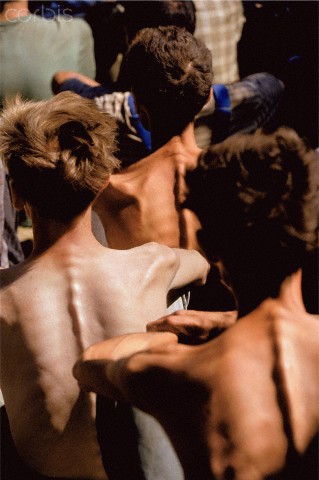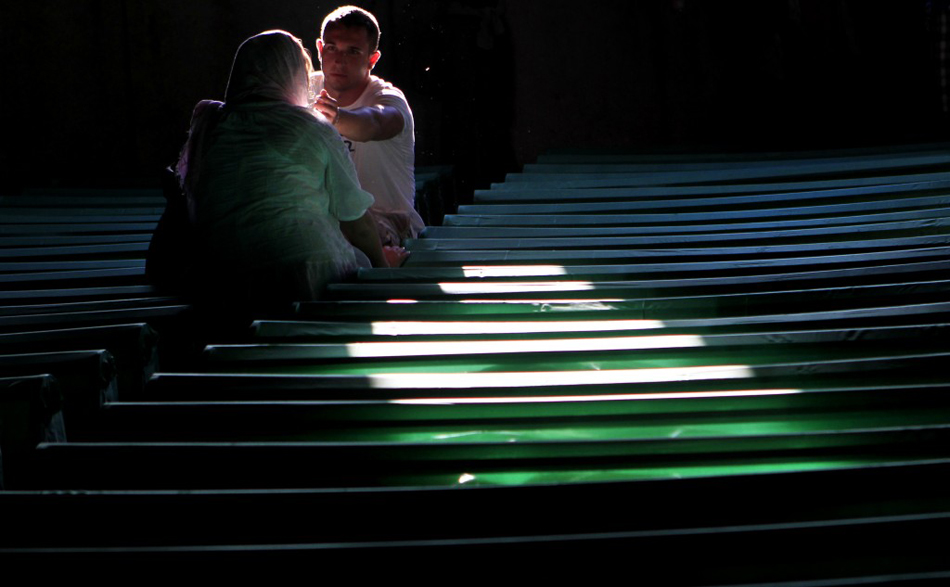19th Anniversary of the Prijedor Genocide
Genocide in Prijedor is a black spot on the conscience of the international community and on the conscience of those who committed the crime
On 6 December 2021 The New York Times described a May 1992 attack in Prijedor:
“When the attack began, Serbs from the village guided the tanks to the homes of certain Muslims…and the inhabitants were asked to come out and show their identity cards. Many of those who did were summarily executed…The bodies of the dead were carried away by trucks, which left a trail of blood. Those not killed on the spot were transferred to a convoy heading toward Omarska, a Serb concentration camp.”
19th Anniversary of Prijedor Genocide
 Institute for Research of Genocide of Canada {IRGC} wants to show respect of the dignity and humanity of the victims of the genocide that happened in Prijedor. We express our regret for the destruction of life, and our solidarity and compassion for the suffering of the victims. All the killed ones are important to us, it is important that their suffering is recognized and respected, because, without that, their families and entire communities of victims of genocide in Prijedor cannot overcome the past, nor can they accept reconciliation without accountability.
Institute for Research of Genocide of Canada {IRGC} wants to show respect of the dignity and humanity of the victims of the genocide that happened in Prijedor. We express our regret for the destruction of life, and our solidarity and compassion for the suffering of the victims. All the killed ones are important to us, it is important that their suffering is recognized and respected, because, without that, their families and entire communities of victims of genocide in Prijedor cannot overcome the past, nor can they accept reconciliation without accountability.
IRGC wants to show that those murdered left the deepest marks in our lives, and that ignorance or indifference towards what happened to the victims is, in fact, the denial of their and our human dignity. We want to share the sorrow, compassion, solidarity and responsibility towards the victims of genocide with our fellow Canadian citizens.
On this occasion, we want to point out again that the arrest and extradition of Ratko Mladic, indicted for genocide in Bosnian and Herzegovina and for other most serious war crimes, to The Hague Tribunal is extremely important act. However, as the arrest was made after 16 years, we demand from the representatives of the Serbian institutions to launch an investigation and find out who hid, protected and guarded Mladic all these years. In what military and/or other facility was he kept? How much has the hiding of Mladic cost the citizens of Serbia? If, in due time, representatives of the Serbian institutions do not provide the answers to these and other questions, it will be clear that the arrest was solely a pragmatic act, which has nothing to do with justice for victims, nor with the changing of the system of values and the abandonment of ideological, moral and cultural patterns that enabled and justified war and war crimes, and turned criminals into heroes.
The Trial Chamber found that the takeover of Prijedor was an illegal coup d’état
As the Trial Chamber found in its decision, the Serb takeover in Prijedor was accompanied by and accomplished through the commission of atrocities on a massive scale, including the establishment of internment camps at Omarska, Keraterm and Trnopolje. These atrocities include frequent killings, rapes and sexual assaults. Moreover, thousands of individuals were subjected to inhuman and degrading treatment, including routine beatings and torture. The cleansing of Prijedor also resulted in the expulsion of Bosniaks from their homes as well as their deportation in huge numbers, often in convoys organized and supervised by Serb authorities. According to the Trial Chamber, more than 20,000 civilians were victims of the expulsion campaign and more than 1,500 were killed in massacres carried out by Serbs during the takeover. Others have reported that the death toll from the internment camps was equally high - according to one source, nearly 2000 Bosniaks died at Omarska alone. We first heard of Omarska in the summer of 1992. That is when Roy Gutman, a foreign correspondent working for Newsday, reported on the existence, at a mining complex, of a camp run by Bosnian Serb militants that held several thousand non-Serb prisoners, primarily Bosniaks but also Croats. Based on the later reports of the detainees who survived their ordeal at Omarska, Gutman called it a ‘‘death camp’’ and reported on the appalling conditions and the rape, torture and execution of detainees. International reporting, especially by British journalists Ed Vulliamy, Penny Marshall and Ian Williams, exposed the horrors of Omarska and ultimately forced the camp to close. After Omarska, it became clear to many people that, in Bosnia, we were dealing with evil on such a scale that can neither be explained away nor ignored. Eventually, the internationally community organized an international tribunal to prosecute war crimes, crimes against humanity and genocide in the former Yugoslavia. The tribunal convicted several of the camp guards, commandants and associated others for crimes committed at Omarska. Read more
My heart is in Srebrenica
My heart is in Srebrenica
By Suzana Vukic
I believe every person has a heart and if you can reach it, you can make a difference.” - Uli Derickson
My heart is in Srebrenica, but I can’t physically be there - not this summer. Yet it’s still possible to connect with the victims and survivors of the Srebrenica Genocide, to hear their voices and stories.
New Yorker Senahid Halilovic, a man who survived Srebrenica, told me his story. His triumph is overshadowed by loss: Senahid’s father and three brothers were killed in this genocide. He lost a total of 70 relatives in Srebrenica.
Senahid has returned to Srebrenica three times since settling in the U.S. in 2002. His father and three brothers are buried at the cemetery and memorial centre in Srebrenica-Potocari. But this summer, Senahid will be participating in the Peace March for the first time ever. It’s a march (also alternately known as the death march, or march to freedom) that commemorates the route that Bosniak (Bosnian Muslim) men from Srebrenica took in July, 1995 in an attempt to escape certain death when Bosnian Serb forces, led by Ratko Mladic, overtook the U.N.-protected enclave. It precedes the July 11th commemoration and communal burial.
In 1993, the visiting U.N. General Philippe Morillon promised safety to the people of Srebrenica: this town became a demilitarized U.N. safe zone. But on July 11, 1995, the day that Srebrenica fell into the hands of Mladic’s forces, Senahid (who was 23) was convinced he’d perish if he remained in Srebrenica. Town elders suggested they all collectively present themselves at the U.N. base to seek safety. But Senahid and his peers felt all “capable” men of fighting age would be better off escaping through the woods and mountains to reach free Bosnian-held territory, rather than to depend on the mercy of the U.N. and Serb forces. “….This way, I could give myself a 50% chance of survival. By going to the U.N. base, I figured I could give myself a 1% chance for survival…..In the end, sadly, we all know what happened to them (men who went to the U.N. seeking safety)….”, he explains.
What followed was a harrowing venture through difficult terrain and circumstances. Senahid estimates that a total of 15,000 people left Srebrenica that night under the cover of darkness, including some older people, women and girls, all seeking survival. People were hungry, terrified and desperate. They formed a column and were directed by guides and leaders who had knowledge of the terrain and sought out the best paths to take in order to ensure the survival of the greatest number of people.
They went through forests, mountains, and ruined and abandoned Bosniak villages that had been overtaken by Serb forces in 1992. They often came under attack by Serb forces during their trek; they were shot at or had bombs and grenades thrown in their direction.
Senahid made it to safe, Bosnian-held territory somewhere on the night of the 16 (going into the 17) of July. He estimates that roughly 3000 people trickled through in the following days. But many were captured and killed before they could reach freedom.
While on the run, his survival instincts had taken over. Once he reached freedom, however, all of the horrible images of what he’d lived through came flooding back to him. Senahid found his mother at a refugee tent at the Tuzla airport, but his father and three brothers would never be seen alive again. His grief-stricken mother cried incessantly. To escape the horrors of the past, Senahid signed up for university courses and earned a degree in chemical engineering by 2001. That year, Senahid went to Croatia. By 2002, he resettled in the United States, where he lives today with his wife and three children.
What are Senahid’s expectations for the Peace March, after so many years since his narrow escape from death? He expects it to be a difficult, emotional experience. On the other hand, Senahid is glad to have the opportunity to revisit the path to freedom that he took so many years ago.
“…I consider it (the Peace March) to be an obligation, not only for myself, but an obligation belonging to all people who carry within themselves a sense of humanity”, explains Senahid.
With this reminder of obligation, I renew my personal commitment to one day visit the cemetery and memorial centre at Srebrenica-Potocari and to participate in the Peace March.
Questions or comments: [email protected]
Suzana Vukic is a freelance journalist, who reports extensively on the Balkans and Member of the International Expert Team of the Institute for Research of Genocide of Canada
http://www.hudsongazette.com/Columns.html
The University of Sarajevo has awarded Mr. Brian Masse and Emir Ramic, Director of the with the prestigious academic award, the Golden Badge of the Sarajevo University
July 12. 2011
The Institute for Research of Genocide- Canada Read more
Statement by Minister Baird on Anniversary of 1995 Srebrenica Massacre
In memory of all the many, beautiful souls who once populated the land of Bosnia and Herzegovina
Brian Masse, MP, to participate in Srebrenica Remembrance Day
Read more
Charlotte Mayor Anthony Foxx Honors Srebrenica Genocide Victims
Charlotte Mayor Anthony Foxx Honors Srebrenica Genocide Victims
July 9, 2021 Read more
State of Michigan Senate adopted the resolution commemorating Srebrenica genocide
State of Michigan Senate adopted the resolution commemorating Srebrenica genocide
July 9, 2021 Read more
A Statement by the Institute for Research of Genocide of Canada (IRGC) marking the 16th Anniversary of the Srebrenica Genocide
The victims of genocide in Bosnia remember and will continue to remind the world of what happened in Bosnia and Herzegovina
The IRGC is appreciative of the fact that the Canadian Parliament has adopted a resolution commemorating and honoring all the victims of the Srebrenica Genocide. It is a noble and important gesture that the Canadian Parliament has made in calling on all Canadians to commemorate appropriately the anniversary of the Srebrenica Genocide. The victims and survivors of Srebrenica are aware that the past cannot be changed, but are encouraged to see in this recognition of their pain by the Canadian Parliament a signal that Canada will not be a silent party to crimes against humanity, wherever they may take place. The IRGC applauds that commitment, remembering and concerned to remind the world what happened during those days in July 1995. Read more


